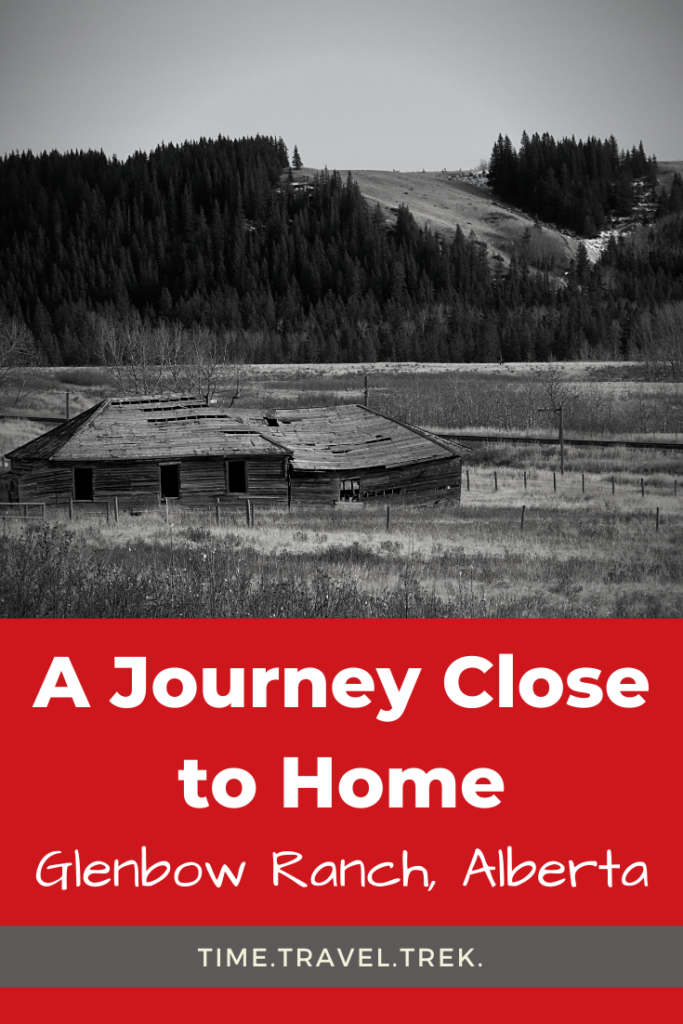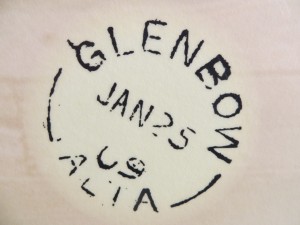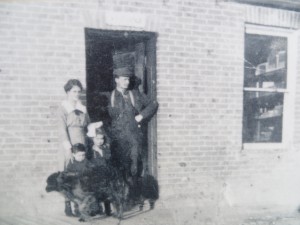Some historical journeys are shorter than others. Just off the highway near our hometown, down a winding gravel road, is a little slice of the past. In a meadow beside a river called the Bow is a weathered grey building. You can’t drive up to it. You have to purposefully travel down a path, back down in time, to a place that now only spirits call home. The ramshackle building, once a post office and school, is all that remains from a townsite that was home to 150 people in the early 1900s. Walking Glenbow Ranch is a scenic sojourn into the past. Join us!
Disclosure: This post contains affiliate links. If you buy something from one of our affiliates, we receive a small commission at no extra charge to you. Thanks for helping to keep our blog up and running!

Table of Contents
Walking Glenbow Ranch and Heading into the Past
The closer you look at the site from a perch up on one of the hills at Glenbow Ranch, the more you see. Scanning the fescue grasslands it becomes easy to visualize herds of bison moving through as they grazed the prairie. Look closer and you’ll see tipi camps of the native tribes that depended on the bison for their survival.
This land has a past dating back thousands, not just hundreds of years. According to historic archaeologist and author Shari Peyerl’s blog, there are 27 prehistoric sites recorded in the park. These include tipi rings and a bison kill site.
Settle in for a spell and you will witness change. The bison are now gone from the landscape. Cattle from the historic Cochrane Ranche have taken their place. Move ahead slightly in time and watch as a ribbon of wood and steel is built through the valley bottom. By 1891, Glenbow became a water stop for the Canadian Pacific Railway’s steam engines. Twelve years later, a CPR station was built here.
Becoming a Townsite
Walk a little further and let your gaze travel up on to the hillsides. There you’ll see remnants of another era. In 1904, Stephen Moore and his sister Mary settled in the area. They took notice of the large outcroppings of sandstone.
By 1906, the sounds of quarrying rang out across the valley. Sandstone blocks, hewn from these hills were used in the construction of Alberta’s Legislature Building in Edmonton as well the courthouse and land titles building in Calgary. A growing population meant a demand for a postal service and in 1909, the post office building was open for business.
Historic sites in the park include early ranch sites as well as the Glenbow Quarry and townsite with its associated General Store and Post Office building. The store/post office was a relocated farmhouse that was added on to as needed. It operated for nine years.

Charles Rhodes de la Vergne was a wealthy American who decided to take up sheep and horse ranching near Calgary. By 1909, he owned the land beside the Glenbow Quarry. He also had the Glenbow townsite surveyed on his property.
A few of de al Vergne’s relatives and friends also built overlooking the valley. The area was dubbed Millionaires’ Hill. Family friends, Dr. Dudley Morris and his wife, Gertrude built near today’s park visitor centre. You can see two fireplace place chimneys from their home in the picnic area that now graces the location.
When the quarry closed in 1912, a brick-making plant was opened and soon 100,000 bricks a day were being manufactured. The wooden frame of the post office building was originally painted green and then faced with brick.

Following the Brick Path
Glenbow bricks – still visible in a few of the older homes in the nearby town of Cochrane – were yellowy-orange to red in colour. Unfortunately, these bricks tended to crumble easily over time and the brick plant had a short lifespan. In 1914, the brick-making plant was closed.
The post office and store stayed in business until 1918 before shutting down forever. After the store close, the building became a granary. After the floor collapsed, the building was abandoned. The last Glenbow residents moved away in 1927.
From Glenbow Townsite to Glenbow Ranch
The property was bought by from Charles de la Vergne by lawyer Eric Harvie in 1934. Harvie started his own law practice in 1935, but wise investments in mineral rights reaped huge rewards. Eric Harvie would become one of the wealthiest people in Canada.
Glenbow Ranch was taken over by his son Neil in 1953. Ownership was then passed down to Neil’s son Tim and daughters Katie, Pauli and Carol. In 2007, the Harvie family established the Glenbow Ranch Park Foundation to help protect and preserve this special area.
Isn’t it amazing what you can see when you look back in time? Some historical journeys are shorter than others; some are found in our own backyards. Go walking in Glenbow Ranch. It’s a scenic walk near Calgary with a whole lot of history to share.
When You Go
Glenbow Ranch Provincial Park is located 10 minutes east of the Town of Cochrane. Access is view the Glenbow Road, south of Highway 1A.
You might also be interested in visiting the nearby Cochrane Historical Museum for additional history on the local area.




Leave a Reply